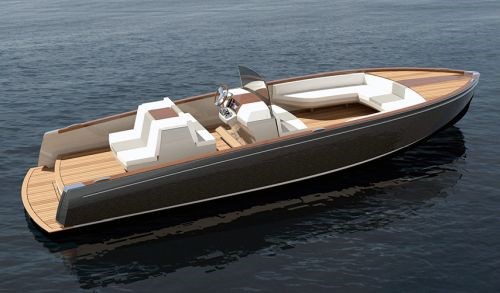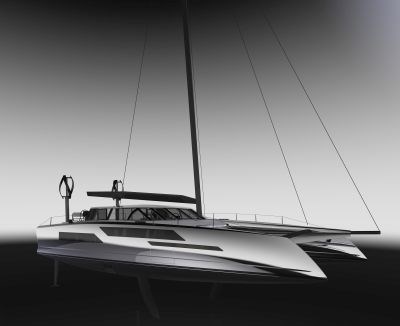First all-electric production yacht features carbon fiber construction
Leader in luxury yacht innovation commits to fossil fuel-less future

The Dasher all-electric boat uses carbon fiber/epoxy composite hull and stringers and an epoxy composite deck painted to look like teak.
SOURCE: The Hinckley Co.
Hinckley Yachts (Southwest Harbor, ME, US) has been renowned for building the highest-quality luxury yachts since 1928. It has also gained a reputation for leadership in product development, epitomized by its Picnic Boat.
Introduced in the early 1990s, the Picnic Boat was described as a sporty “high-tech overnighter, shoal-draft boat, which featured resin-infused, Kevlar/glass fiber hybrid composite construction. The 36-ft hull weighed in at a mere 2,300 lb. (For comparison, the composite hull of a 2017 model 20-ft Pro-Line center console power boat weighs 2,600 lb.) The Seeman Composites Resin Infusion Molding Process (SCRIMP) develop by marine composites legend Bill Seeman was pretty new, and Hinckley was one of the first recreational boatbuilders to license the technology.
Another “first” for the Picnic Boat was the option to power it with a Hamilton jet drive. Though waterjets were not unknown, they weren’t normally associated with luxury yachts. In the Picnic Boat, however, the jet drive enabled an 18-inch draft for exploring shallow waters and elimination of propellers (no snagging lobster pot lines) as well as engine noise.
The boat was also a pioneer in its Steven Jobs-like ability to deliver a product that customers didn’t even know they wanted, but once introduced, found irresistible. It was a visionary product, one I heard referred to as a “Mercedes coupe on the water”.
450 hulls later, the Picnic Boat 37 MKIII has maintained jet propulsion but now with a patented joystick control, and its composite construction has moved on to carbon fiber/glass hybrid construction, part of an overall program to cut weight by 1,000 lb and increase top speed from 29 to 35 knots.
First fully electric luxury yacht
Now, Hinckley has again moved out in front, with the launch of its Dasher all-electric motor yacht. Named after the Picnic Boat hull #1 “Dasher”, this 28.5-ft fossil fuel-free runabout features modern styling from long-celebrated designer Michael Peters and 3D printed titanium hardware and console details. It is the lightest Hinckley Yacht yet (6,500 lbs fully equipped) via a resin-infused carbon fiber/epoxy composite hull (Picnic Boats used vinylester resin) and carbon composite stringers, plus an Artisanal Teak deck that is actually an epoxy composite hand-painted to look like varnished teak, offering much less weight and maintenance and much improved sustainability.
For those dismissing the reality of electric boats, they were in fact the norm before the 1930s. Dasher’s Whisper Drive propulsion system is powered by twin Deep Blue 80i 1800 electric motors from Torqeedo (Starnberg, Germany), each powered by a 40-kilowatt-hour (kWh) BMW i3 lithium ion battery. Cruising at 10 mph, range is 40 miles, or 25 miles at speeds of 18-27 mph. (Fossil fuel comparison: a 28.5-ft Boston Whaler power boat with twin 225-hp outboards travelling at 10 mph will burn about 9.5 gallons/hr.)
Note that Torqeedo is also being used by Daedalus Yachts in its new carbon composite sailing catamarans.

Dasher’s single touchscreen control on the console shows the boat’s GPS location, complete with translucent overlay of range, based on speed, distance traveled and power system parameters. Recharging is reportedly twice as fast as popular all-electric cars, with full charge possible in under four hours using a pair of standard 50-amp lines. And charging infrastructure is already in place — almost all marinas already provide dockside power.
Dasher also features a retractable windshield and below waterline thruster for even more fine maneuvering control with Hinckley’s patented joystick system.
Reservations are now being accepted for delivery of Dasher yachts in Summer 2018.
Though electric boats have been heralded as the future for almost as long as electric cars, the pace now seems to be quickening, enabled by increased development in power systems and battery/energy storage technology. Just as composites are predicted to be a valuable enabler of range-and performance extending lightweight for plug-in cars, it seems already the construction of choice for performance boats without the noise, smell, cost and environmental impact of gas and diesel fuel.
Related Content
Novel dry tape for liquid molded composites
MTorres seeks to enable next-gen aircraft and open new markets for composites with low-cost, high-permeability tapes and versatile, high-speed production lines.
Read MoreMaterials & Processes: Resin matrices for composites
The matrix binds the fiber reinforcement, gives the composite component its shape and determines its surface quality. A composite matrix may be a polymer, ceramic, metal or carbon. Here’s a guide to selection.
Read MoreThe making of carbon fiber
A look at the process by which precursor becomes carbon fiber through a careful (and mostly proprietary) manipulation of temperature and tension.
Read MoreMaterials & Processes: Composites fibers and resins
Compared to legacy materials like steel, aluminum, iron and titanium, composites are still coming of age, and only just now are being better understood by design and manufacturing engineers. However, composites’ physical properties — combined with unbeatable light weight — make them undeniably attractive.
Read MoreRead Next
IBEX 2017 show report
Increased attendance and exhibitors despite Irma, continued delivery of latest in composite technologies for marine industry.
Read MoreCW’s 2024 Top Shops survey offers new approach to benchmarking
Respondents that complete the survey by April 30, 2024, have the chance to be recognized as an honoree.
Read MoreFrom the CW Archives: The tale of the thermoplastic cryotank
In 2006, guest columnist Bob Hartunian related the story of his efforts two decades prior, while at McDonnell Douglas, to develop a thermoplastic composite crytank for hydrogen storage. He learned a lot of lessons.
Read More

















.jpg;maxWidth=300;quality=90)








